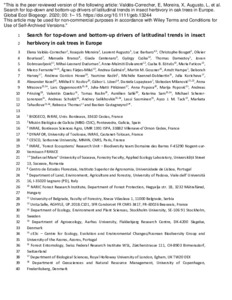Search for top-down and bottom-up drivers of latitudinal trends in insect herbivory in oak trees in Europe
Damestoy Thomas; Sam Katerina; Schuldt Andreas; Queloz Valentin; Milanović Slobodan; Tack Ayco JM; Kaennel-Dobbertin Michèle; Barbaro Luc; Opgennoorth Lars; Kadiri Yasmine; Faticov Maria; Castagneyrol Bastien; Duduman Mihai-Leonard; Scherer-Lorenzen Michael; Hampe Arndt; Howe Andrew Gordon; Suominen Lassi; Harvey Deborah; Roslin Tomas; Gossner Martin M.; Fürjes-Mikó Ágnes; Augusto Laurent; Eötvös Csaba B.; Tahadlova Marketa; Dulaurent Anne-Maïmiti; Thomas Rebecca; Lövei Gábor L.; Moreira Xoaquín; Popović Marija; Bouriaud Olivier; Koricheva Julia; Sallé Aurélien; Popova Anna; Dobrosavljević Jovan; Centenaro Giada; Csoka György; Lupaștean Daniela; Prinzing Andreas; Bouget Christophe; Branco Manuela; Ferrante Marco; Pitkänen Juha-Matti; Kozel Alexander; Galmán Andrea; Mrazova Anna; Selikhovkin Andrey; Kozlov Mikhail V.; Valdés-Correcher Elena
https://urn.fi/URN:NBN:fi-fe2021042821317
Tiivistelmä
Aim
The strength of species interactions is traditionally expected to increase toward the Equator. However, recent studies have reported opposite or inconsistent latitudinal trends in the bottom‐up (plant quality) and top‐down (natural enemies) forces driving herbivory. In addition, these forces have rarely been studied together thus limiting previous attempts to understand the effect of large‐scale climatic gradients on herbivory.
Location
Europe.
Time period
2018–2019.
Major taxa studied
Quercus robur.
Methods
We simultaneously tested for latitudinal variation in plant–herbivore–natural enemy interactions. We further investigated the underlying climatic factors associated with variation in herbivory, leaf chemistry and attack rates in Quercus robur across its complete latitudinal range in Europe. We quantified insect leaf damage and the incidence of specialist herbivores as well as leaf chemistry and bird attack rates on dummy caterpillars on 261 oak trees.
Results
Climatic factors rather than latitude per se were the best predictors of the large‐scale (geographical) variation in the incidence of gall‐inducers and leaf‐miners as well as in leaf nutritional content. However, leaf damage, plant chemical defences (leaf phenolics) and bird attack rates were not influenced by climatic factors or latitude. The incidence of leaf‐miners increased with increasing concentrations of hydrolysable tannins, whereas the incidence of gall‐inducers increased with increasing leaf soluble sugar concentration and decreased with increasing leaf C : N ratios and lignins. However, leaf traits and bird attack rates did not vary with leaf damage.
Main conclusions
These findings help to refine our understanding of the bottom‐up and top‐down mechanisms driving geographical variation in plant–herbivore interactions, and indicate the need for further examination of the drivers of herbivory on trees.
Kokoelmat
- Rinnakkaistallenteet [19207]
